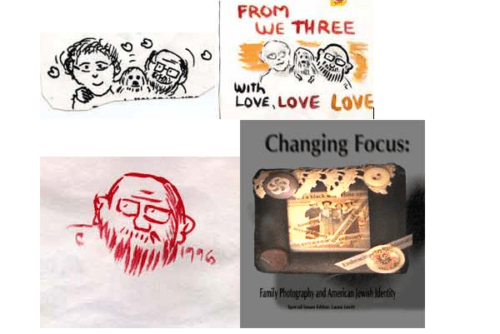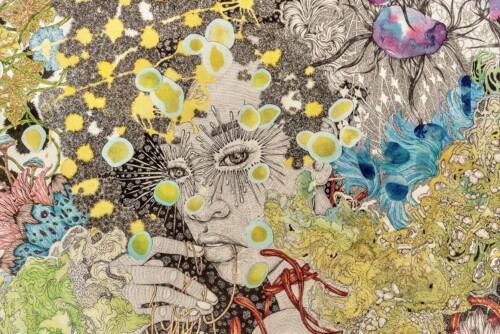Gender: Production and Display
In the family I grew up in, making paintings and drawings is a masculine enactment.1 Levitt men are artists; they paint and they draw. These practices are a regular part of their everyday lives. This is not a regular part of what Levitt women do. We are not the makers of images. Our drawings are crude, unworthy of display, public or private. Our role in the economy of these visual arts2 is as viewers. We are the primary supporters of these homeworks. We operate behind the scenes. We put the paintings on the walls; we share them with others. Those who know my mother and me would find this behind-the-scenes role out of character. In nearly all other ways, each of us likes to take center stage. Here our relationship to these art works is to ensure their place center stage. Over the years, I now notice, my mother and I have each come to make possible the public display of not only the visual works of Levitt men, but the works of a broad range of artists, both women and men.3
My mother and I play out a gendered relationship to the visual, both at home and in public. For us making home is making a place for pictures. Our role is to support people who make works of art. My mother has become, literally, a patron of the visual arts in Delaware, while I write about family pictures and photographs of American Jews. Among many other things, she has served on the Delaware State Arts Council and been its vice-chair. She has chaired the Governor’s Awards for the Arts and also been the force behind a five-year initiative to open up the diversity of artistic production in Delaware through “A Collage of Cultures: Many Visions, One Community” (1995-2000). She was the Project Coordinator for “Collage,” as an initiative of the Dover Art League where she continues to serve on the board, currently as president. In this capacity she wrote annual grants, put together five publications, mounted each exhibition, arranged other cultural events around each show and literally collected artists from across the state to participate in each of these programs. I have been working with filmmakers, photographers, collage and conceptual artists not only on this project but in my role as director of the Jewish Studies Program at Temple. The role of admirer and supporter of the arts is a feminine enactment in my family.
Within the economy of my immediate family, this gendered labor of artistic promotion and display has been especially crucial for my mother because my father is constantly producing new works that require her attention. He paints and paints while she buys frames and finds new places to display each of these new creations.
By contrast, neither my brother nor I engage in these gendered activities on a daily basis. We do these things on occasion as occasioned. Although I write about photography and have both taught and written about next generation art about the Holocaust,4 I do not do these things with nearly the zeal of my mother. I am a less behind-the-scenes person than she is. In my work the art is always addressed, as in this essay, within the context of my own larger project. It has been a part of my efforts to explain various aspects of contemporary Jewish identity.
Producing art and promoting it is part of what my brother and I learned about masculinity and femininity growing up in this household. For me, as a girl, this meant appreciating but not producing pictures. For my brother, this meant acquiring a whole set of skills and practices for painting and drawing that were to become a normal and natural part of his adult life. Despite these clear messages about producing art, the meaning and import of this work was a bit more complicated. The legacy my brother inherited was about making art. It was not about display. And, despite the clarity of the lessons we each learned about our gender roles in relation to picture-making, my brother and I did not inherit the fervor, the excess that marks our parents’ engagement with these practices. My brother does not produce the sheer quantity of pictures that my father does. He does not paint or draw everyday, nor are the vast majority of his pictures self-portraits. And, although I am an enthusiastic supporter of my father’s art and engaged in critical readings of other kinds of images in my own work, I am not my mother; the walls of my house are relatively bare. What is the desire that my parents are so driven to express in this particular way? And why do I resist it?
- I began to think about these issues in terms of gender for the presentation I did at Barnard in January of 2001. Marianne Hirsch’s original presentation was about gender and family photographs, and it was her talk and the e-mail discussions we had prior to that event that led me to consider these issues in my own family. Marianne’s talk was about how her parents had each responded differently to donating family photographs to the archives of United States Holocaust Memorial Museum in Washington, D.C. I thank Marianne for sharing a copy of that talk with me. Marianne Hirsch, unpublished presentation manuscript, January 2001. [↩]
- I do need to note that this is a discussion about visual art, painting and drawing and not artistic production in three dimensions. Work with clay or sculpture is different. It is a practice my brother and I have both done and our pieces are on display in my parents’ house, but these are minor works. They do not take up the kind of physical or psychic space that the paintings and drawings do. They were also produced outside of the confines of this home. They are high school and college creations. [↩]
- It should be noted that this is not all any of us do. We do more than these neatly scripted gendered roles. Nevertheless this is a site where gender differences have been most pronounced. Although we all work with words, the production of visual images is a uniquely masculine enactment in my immediate family. For an example of my promotion of the arts in my own work and writing see Laura Levitt, “Photographing American Jews: Identifying American Jewish Life,” in Mapping Jewish Identities, Laurence Silberstein ed., (New York: NYU Press, 2000), 65-96. This special issue is another example of this move to writing about visual culture in my own work. [↩]
- Shelley Hornstein, Laurence Silberstein and Laura Levitt, ed., Sighting the Holocaust: Contemporary Visions (New York: NYU, forthcoming). [↩]



